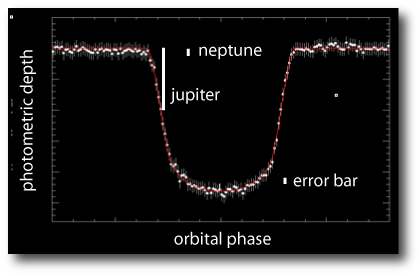
Image Source.
The CoRoT satellite fired off its first planetary dispatch today. Here’s a link to the CNES press release. It now appears that CoRoT has the photometric sensitivity to eventually reach down to planets of approximately Earth-size, and in the immediate near future, the mission stands a good chance at bagging the first discovery of a transiting sub-Neptune mass planet.
The prospect of seeing a 10-Earth mass planet in transit has everybody all worked up, and for good reason. The moment a transiting example of a planet like Gl 581 b (or c) turns up, then we’ll know whether it formed in-situ (in which case it’ll be small and thus made of rock and iron) or whether it migrated in from colder regions of the protoplanetary disk (in which case it’ll be relatively large and thus made mostly of water).
Here’s a slightly reworked version of the light curve accompanying the press release.

So far, there doesn’t seem to be such a thing as an “average” extrasolar planet. Nearly every new world that turns up has at least one unusual, completely unexpected characteristic. This week so far has been no exception. Hat-P-2b sports an extraordinarily high orbital eccentricity. X0-2b appears to have a very large complement of heavy elements, which gives it a comparatively high density and a comparatively small radius. CoRoT-Exo-1b is distinguished by its enormous size.
The CoRoT press release quotes a radius of 1.68 Jupiter radii for their 1.3 Jupiter-mass planet. The planet’s orbital period is short (only 1.5 days) and its surface temperature is high — probably ~1500-1800K — but its still quite a bit larger than the 1.45 Jupiter-radius that our models predict. A powerful internal heat source seems to be necessary to get the planet up to the large observed radius.
Or alternatively, the star may be somewhat smaller in size than the best-fit value. It’s notoriously difficult to get accurate radii for stars that don’t have parallax measurements.

the secondary minimum and albedo? :)